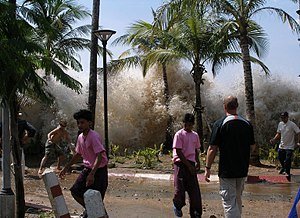Tsunami (Japanese: 津 波 [tsɯnami] literally means 'harbor wave') [1] A type of tidal surge, in fact tsunami, is the biggest loss in the rainstorm. [2] In the English language: tsunami pronunciation: / (t) suːnɑːmi / (t) soo-NAH-mee) Sulfur or waves caused by the earthquake, landslides or volcanic eruptions in the seas or rivers or any other water field.

Naming
The name "tsunami" is derived from the Japanese language word. The Japanese word is written in English as "Tsunami", as is the first name of the name "Tsunami" in Bengal itself. Later, the pronunciation, that is, "tsunami" accepted unanimously.
The cause of tsunami creation
Tsunamis can be caused due to various reasons. Among the reasons for earthquakes, volcanic eruptions, landslides Among them are two reasons:
Earthquake occurring 20-30 kilometers deep in the sea level;
Sudden emergence and collapse of tectonic plates
Earthquake in the depth of 20-30 kilometers of sea level, it shakes the surface of the ocean floor, and very naturally shakes the water related to it. When the earth's vibration takes place in the water, it can cause tsunami. Also, the effects of the carbon cycle are due to the movement of tectonic plates in the interior. In this way, if one plates constantly pushing the other plate upside down, then one goes up one another. Then the crust of that place gets bumpy, even in such a way, the crust may suddenly get elevated from small hill to hill. When the crust below the sea, river, water body or any other large water body swells like this, the water of that water can be swollen and tsunamite.
Details
In the case of tsunamis, the swelling of the water due to vibrations or tension creates large waves of solutan, and it spreads evenly to all levels. These waves quickly fall into the shores or on the shores. In the case of the vast ocean, the rising waves moved towards nearby lands. Sometimes these hills become weak in coming to push equal water, huge water bodies. But sometimes the intensity of the storm is overcome by all the obstacles, or the rising depth of the crust against the land surface can hit the nearby lands without any obstruction. In such a horizontal bore, there is huge loss of life and property in coastal areas. Although volcanic eruptions are below the water, water can swell and cause tsunamis. Although there may be landslides from any land area, it can cause such tsunamis in the water.
The tsunami that is always a huge wave is not exactly right. Sometimes it may be that, while deep in the ocean, the tsunami wave went down the boat, but it was not found. The main reason is that the bottom of the ocean is very deep and the inflated water can easily be found in the stable system. But as much as the ocean is near the land, the more sea is being shallow, so these waves also start to form the peak. Some tsunamis may be up to 100 feet (30 meters) in height to move towards the ground. So far the biggest tsunami was measured in 212 feet (65 meters).
Tsunamis in deep water can be up to 600 miles per hour (1,000 kilometers) per hour. The tsunami wave is usually not one, some are continuous, and the distance from one wave to another wave can be 100 miles (160 km). So it is about 1 hour or a little more time to hit a big wave and the second one after one hour and the third one, thus, waves can hit the ground.